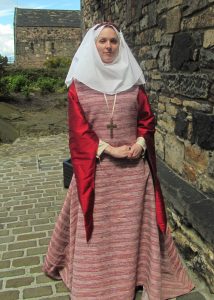The Friday Feature – No.1
We have many costumes in our collection along with props to help tell stories. We have also been able to work in some wonderful locations that are now closed because of the current crisis. We take lots of photos and rarely have the chance to share them with you. We have decided to share these with you now and give you a peek into our world of work with our new Friday Feature.
Queen Margaret of Scotland
The week we feature Queen Margaret of Scotland, wife of Malcolm Canmore who is best known for being the Malcolm in the Shakespeare’s Scottish play. Here we see the queen at Edinburgh Castle with the chapel built by her son and dedicated to her memory, in the distance. This chapel is the oldest building in Edinburgh,

Margaret’s costume is made up of the following components – a kirtle, a cote hardie and a surcoat. On her head she wears a wimple held in place by a braid headpiece on which she wears a crown.
The Costume
- The kirtle: this is worn next to the skin. For the poor this all that they would probably have worn. For the Queen, this was an undergarment that no one saw except her husband and possibly her closest women servants.
- The cotehardie: this is the next layer and is the red dress with the pointed sleeves and buttons. This can be worn without the striped surcoat. It’s really the posh frock for big occasions made of a finer fabric, in this case satin. Buttons were an important development in medieval dress as before the only fastenings were lacings. Buttons meant clothes could be fancier as seen here.
- The surcoat: the striped dress with the side lacing was worn on top of the cotehardie as something more practical for daily life. It also a helped to keep the wearer warm. The “sur” part of the word comes from the French word meaning “on”. It’s worn on top of something else.
- The head-dress – it’s called a wimple. All married women had to cover their heads mainly because of their earlobes! Earlobes were considered highly attractive in the medieval period – hence the covering of them after marriage!
Why Red?
The stained glass window in the chapel at Edinburgh Castle features Queen Margaret in blue, a colour she is extremely unlikely to have worn in her lifetime. This is because the colour blue was associated with the Virgin Mary. The window in her chapel is Victorian and depicts her as a saint.
Her Influence on the Scottish Court
Margaret was an Anglo Saxon princess born in Hungary who became Queen of Scotland. Her influence on the Scottish court is important.
- She is credited with improving the behaviour of the male courtiers when they were on progress around Scotland. Previously they had helped themselves to whatever they wanted as they travelled around with the King, now they were to only take what was offered them by their hosts.
- She also encouraged the wearing of richer, brightly coloured fabrics by women courtiers as she had seen in Hungary, thus encouraging trade with abroad.
- Her introduction of the Benedictine Order to Scotland effectively introduced Roman Catholicism to the country and ended the old Celtic Church of St Columba. She built an abbey for the Benedictine Order in Dunfermline at the site of the church where she and Malcolm had married.
- Margaret established the ferry crossings at North and South Queensferry (hence the names today) to enable pilgrims to travel to and from St Andrews. It was a free crossing. She believed that all pilgrims should have the means of getting to St Andrews to visit the relics of Saint Andrew kept in the cathedral there. Many people think the crossings were for getting to and from Dunfermline but it was not a place of pilgrimage at that time.
- She was the mother of 3 kings of Scotland: Edgar of Scotland 1097-1107; Alexander I of Scotland 1107 – 1124; avid I of Scotland 1124 – 1153
- The most remembered of her children are David as King of Scotland and Edith. She is also known as Matilda and married Henry I of England thus reconciling the Anglo Saxon and Norman factions in England. It was Edith/Matilda who had the biography of Queen Margaret written to prove her Anglo Saxon lineage and the importance of her mother.
So little is ever written about women of this time beyond that of being the mother of a certain king, therefore this history, even with its faults, is really important.
Copyright Jackie Lee 2020




